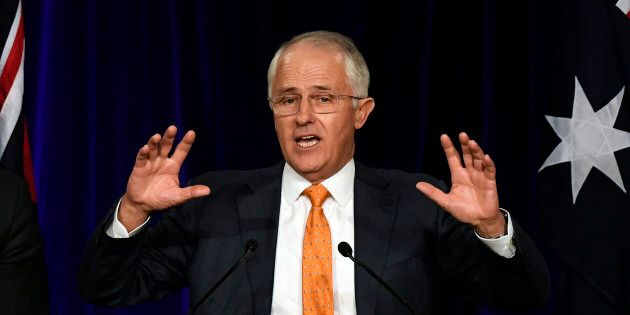
The longest election in recent history has just become a whole lot longer. The nation starts another working week with no outcome and final votes will begin to be counted on Tuesday.
Prime Minister Malcolm Turnbull said he was confident the Coalition would form a majority government on Sunday. But now even Liberals are saying a hung Parliament is likely, with Liberal sources telling Sky News they could claim between 73 and 76 seats.
As speculation continues let's take a look at what is determined, the possible options from here, and why it is taking so long.
A Majority Government
Firstly, to retain a majority government a party needs to hold 76 seats in the House of Representatives (as there are 150 seats in the House of Reps).
The Coalition has won 65 seats and Labor has claimed 67. Five seats have gone to minor parties and independents. This leaves 13 seats in doubt.
Before the election the Coalition held 90 seats while Labor held 55. And with 75 percent of the vote recorded so far, there has been a three percent swing against the Coalition. Which is pretty significant.
Election analyst Antony Green has predicted the Coalition will win up to 75 seats, but said the overall result is too close to call. Green is not willing to say the Coalition will form a majority government.
Hung Parliament
If the Coalition does not pick up enough of the 13 'in doubt' seats to make up 76 seats in Parliament -- and therefore hold a majority -- there will be a hung parliament.
This is essentially when neither party has the majority to pass laws in Parliament so they need to gain the support of other independents or minor parties in the House to form a minority government of 76 seats.
The Coalition is looking likely to pick up more seats than Labor so they would have to negotiate with fewer crossbenchers to get them over the line. And typically the party in power (currently the Coalition) has the ability to negotiate first.
The last time this happened was in 2010 when Julia Gillard formed a minority government with the Greens and independent MPs Rob Oakeshott, Andrew Wilkie and Tony Windsor.
Turnbull told reporters on Sunday he had called a number of crossbenchers following the close results.
"What I have said to them is what I say to you now, we remain confident we will be able to form a majority government and in those circumstances or indeed, in any circumstances, we always seek to work constructively with all of the members of the Parliament," Turnbull said.
What The Senate May Look Like
The senate results may take weeks to come in (they always take longer to count than the lower house of Parliament) but it is not looking good for Malcolm Turnbull.
Turnbull called an early double-dissolution election to pass two industrial relations bills -- the ABCC and Registered Organisation Bills -- to re-introduce a construction watchdog.
The senate had been blocking these bills which prompted Turnbull to dissolves both the Parliament and the senate forcing even the senators with six year terms to run for re-election.
This move was made to ensure the bills would pass after July 2 with a new, more cooperative senate.
But it's looking like the senate could be even messier, with more minor parties predicted to claim senate spots. Pauline Hanson looks to have secured a senate spot, and could claim two more. Derryn Hinch has won a senate spot, along with Jacqui Lambie. And Nick Xenophon could claim three senate spots from South Australia.
However former Palmer United senator Glenn Lazarus and Motoring Enthusiast Ricky Muir may not be returned.
The Coalition looks to have about 30 senate spots so far. To pass legislation they need nine more votes in the senate, from either more Coalition senators or crossbenchers.
Why Is This Taking So Long?
There are more than one million postal votes that have not yet been counted and as 13 seats still remain very close these votes are needed.
The Australian Electoral Commission confirmed they are waiting until postal votes and absentee votes are in and will begin counting again on Tuesday. But legally the AEC have to wait 13 days, so depending on how close the votes remain the AEC said the nation could be waiting for weeks.
On Sunday Malcolm Turnbull said postal votes historically swing in the Coalition's favour (because of the nature of the electors requiring postal votes). An AEC spokesperson would not confirm this on the ABC.
"The reason the result was not clear last night was that around a third of Australians voted in prepolling or via a postal vote," Turnbull said.
"[This is] a very high percentage and one that has been getting higher at each election."
The only thing remaining clear right now is time will tell. And we're going to be waiting at least a couple more days.
Here are some of the big wins and losses in the wash-up of Saturday's vote.
- Malcolm Turnbull is confident the coalition can form a majority government
- Opposition leader Bill Shorten says the coalition has no mandate to govern
- Derryn Hinch and Pauline Hanson have likely won Queensland senate spots
- Linda Burney is the first Indigenous female elected to the House of Representatives
- Nick Xenophon Team's Rebekha Sharkie has won the SA seat of Mayo from Jamie Briggs
- Deputy Prime Minister Barnaby Joyce beat former MP Tony Windsor in New England
- Tasmanian senator Jacqui Lambie has been returned
- The Australian Electoral Commission has apologised for very long queues at many booths
- There has been a huge surge in Australians voting for minor parties